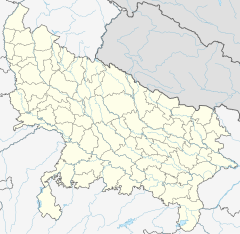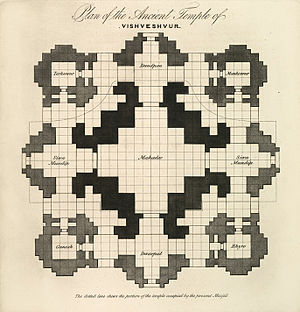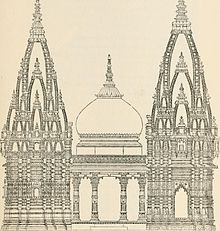Kashi Vishwanath Temple
| Kashi Vishwanath Temple | |
|---|---|
 Kashi Vishwanath Temple, ca. 1915 | |
| Religion | |
| Affiliation | Hinduism |
| District | Varanasi |
| Deity | Vishwanath (Shiva) |
| Festivals | Maha Shivaratri |
| Location | |
| Location | Varanasi |
| State | Uttar Pradesh |
| Country | India |
 Location within Uttar Pradesh | |
| Geographic coordinates | 25°18′38.79″N 83°0′38.21″E / 25.3107750°N 83.0106139°E / 25.3107750; 83.0106139Coordinates: 25°18′38.79″N 83°0′38.21″E / 25.3107750°N 83.0106139°E / 25.3107750; 83.0106139 |
| Architecture | |
| Architectural type | Mandir |
| Creator | Maharani Ahilyabai Holkar |
| Completed | 1780 |
| Website | |
| shrikashivishwanath.org | |
Kashi Vishvanath Temple is one of the most famous Hindu temples dedicated to Lord Shiva. It is located in Varanasi, Uttar Pradesh, India. The temple stands on the western bank of the holy river Ganga, and is one of the twelve Jyotirlingas, the holiest of Shiva temples. The main deity is known by the name Vishvanatha or Vishveshvara meaning Ruler of The Universe. Varanasi city is also called Kashi, and hence the temple is popularly called Kashi Vishvanath Temple. Its name originally was Vishveshvara (broken down Vishwa: Universe, Ish: Lord; Vara: Excellent) or Lord of the Universe.
The temple has been referred to in Hindu scriptures for a very long time as a central part of worship in the Shaiva philosophy. It has been destroyed and re-constructed a number of times in history. The last structure was demolished by Aurangzeb, the sixth Mughal emperor who constructed the Gyanvapi Mosque on its site.[1] The current structure was built on an adjacent site by the Maratha ruler, Ahilya Bai Holkar of Indore in 1780.[2]
Since 1983, the temple has been managed by the government of Uttar Pradesh. During the religious occasion of Shivratri, Kashi Naresh (King of Kashi) is the chief officiating priest.
Contents
1 History
2 Legend
3 Structure
4 Importance of the temple
5 Puja details
6 See also
7 References
8 Notes
9 External links
History
The temple has been mentioned in the Puranas including the Kashi Khanda (section) of Skanda Purana. The original Vishwanath temple was destroyed by the army of Qutb-ud-din Aibak in 1194 CE, when he defeated the Raja of Kannauj as a commander of Mohammad Ghori. The temple was rebuilt by a Gujarati merchant during the reign of Delhi's Sultan Iltutmish (1211-1266 CE). It was demolished again during the rule of either Hussain Shah Sharqi (1447-1458) or Sikandar Lodhi (1489-1517). Raja Man Singh built the temple during Mughal emperor Akbar's rule, but orthodox Hindus boycotted it as he had let the Mughals marry within his family. Raja Todar Mal further re-built the temple with Akbar's funding at its original site in 1585.[3]
In 1669 CE, Emperor Aurangzeb destroyed the temple and built the Gyanvapi Mosque in its place.[4] The remains of the erstwhile temple can be seen in the foundation, the columns and at the rear part of the mosque.[5]

Gyanvapi Mosque, sketched as Temple of Vishveshvur in 1834 by James Prinsep

Plan of the Ancient Temple of Vishveshvur, by James Prinsep[6]

Elevation of the present temple structure
In 1742, the Maratha ruler Malhar Rao Holkar made a plan to demolish the mosque and reconstruct Vishweshwar temple at the site. However, his plan did not materialize, partially because of intervention by the Nawabs of Lucknow, who controlled the territory.[7]:2 Around 1750, the Maharaja of Jaipur commissioned a survey of the land around the site, with the objective of purchasing land to rebuild the Kashi Vishwanath temple.[7]:85 However, his plan to rebuild the temple did not materialize either. In 1780, Malhar Rao's daughter-in-law Ahilyabai Holkar constructed the present temple adjacent to the mosque. In 1828, Baiza Bai, widow of the Maratha ruler Daulat Rao Scindhia of Gwalior State, built a low-roofed colonnade with over 40 pillars in the Gyan Vapi precinct.[8] During 1833-1840 CE, the boundary of Gyanvapi Well, the ghats and other nearby temples were constructed. A 7-feet high stone statue of Nandi bull, gifted by the Raja of Nepal lies to the east of the colonnade. Many noble families from various ancestral kingdoms of Indian subcontinent and their prior establishments make generous contributions for the operations of the temple. In 1841, the Bhosales of Nagpur donated silver to the temple. In 1835, Maharaja Ranjit Singh donated 1 tonne of gold for plating the temple's dome.[7]:200[9]
The temple was managed by a hereditary group of pandas or mahants. After the death of Mahant Devi Dutt, a dispute arose among his successors. In 1900, his brother-in-law Pandit Visheshwar Dayal Tewari filed a lawsuit, which resulted in him being declared the head priest.[10]
Legend
As per Shiva Purana, once Brahma (the Hindu God of creation) and Vishnu (the Hindu God of Harmony) had an argument in terms of supremacy of creation.[11] To test them, Shiva pierced the three worlds as a huge endless pillar of light, the jyotirlinga. Vishnu and Brahma split their ways to downwards and upwards respectively to find the end of the light in either directions. Brahma lied that he found out the end, while Vishnu conceded his defeat. Shiva appeared as a second pillar of light and cursed Brahma that he would have no place in ceremonies while Vishnu would be worshiped till the end of eternity. The jyotirlinga is the supreme partless reality, out of which Shiva partly appears. The jyothirlinga shrines, thus are places where Shiva appeared as a fiery column of light.[12][13] There are 64 forms of Shiva, not to be confused with Jyotirlingas. Each of the twelve jyothirlinga sites take the name of the presiding deity - each considered different manifestation of Shiva.[14] At all these sites, the primary image is lingam representing the beginningless and endless Stambha pillar, symbolizing the infinite nature of Shiva.[14][15][16] The twelve jyothirlinga are Somnath in Gujarat, Mallikarjuna at Srisailam in Andhra Pradesh, Mahakaleswar at Ujjain in Madhya Pradesh, Omkareshwar in Madhya Pradesh, Kedarnath in Himalayas, Bhimashankar in Maharashtra, Viswanath at Varanasi in Uttar Pradesh, Triambakeshwar in Maharashtra, Vaidyanath Jyotirlinga, Deogarh in Deoghar, Jharkhand, Nageswar at Dwarka in Gujarat, Rameshwar at Rameswaram in Tamil Nadu and Grishneshwar at Aurangabad in Maharashtra.[11][17]
The Manikarnika Ghat on the banks of Ganges near to the Kashi Vishwanath Temple is considered as a Shakti Peetha, a revered place of worship for the Shaktism sect. The Daksha Yaga, a Shaivite literature is considered as an important literature which is the story about the origin of Shakti Peethas.[18]
Structure

The original holy well—Gyanvapi in between the temple and Gyanvapi Mosque
The temple complex consists of a series of smaller shrines, located in a small lane called the Vishwanatha Galli, near the river. The linga of the main deity at the shrine is 60 cm tall and 90 cm in circumference housed in a silver altar.[19] The main temple is quadrangle and is surrounded by shrines of other gods. There are small temples for Kaalbhairav, Dhandapani, Avimukteshwara, Vishnu, Vinayaka, Sanishwara, Virupaksha and Virupaksh Gauri in the complex. There is a small well in the temple called the Jnana Vapi also spelled as Gyaan vapi (the wisdom well). The Jnana Vapi well sites to the north of the main temple and it is believed that the Jyotirlinga was hidden in the well to protect it at the time of invasion. It is said that the main priest of the temple jumped in the well with the Shiv Ling in order to protect the Jyotirlinga from invaders.
According to the structure of the temple, there is a Sabha Griha or Congregation Hall leading to the inner Garbha Griha or Sanctum Sanctorum. The venerable Jyotirlinga is a dark brown colored stone which is enshrined in the Sanctum, placed on a silver platform. Structure of the Mandir is composed of three parts. The first compromises a spire on the Mandir of Lord Vishwanath or Mahadeva. The second is gold dome and the third is the gold spire atop Lord Vishwanath carrying a flag and a trident.
The Kashi Vishwanath temple receives around 3,000 visitors every day. On certain occasions the numbers reach 1,000,000 and more. Noteworthy about the temple is 15.5 metre high gold spire and gold dome. There are three domes each made up of pure gold.
Importance of the temple

Street near temple
Located on the banks of the holy Ganges, Varanasi is regarded among the holiest of the Hindu cities. The Kashi Vishwanath temple is widely recognized as one of the most important places of worship in Hindu religion. Inside the Kashi Vishvanath Temple is the Jyotirlinga of Shiva, Vishveshvara or Vishvanath. The Vishveshvara Jyotirlinga has a very special and unique significance in the spiritual history of India.
Many leading saints, including Adi Sankaracharya, Ramakrishna Paramhansa, Swami Vivekananda, Bamakhyapa, Goswami Tulsidas, Swami Dayananda Saraswati, Sathya Sai Baba and Gurunanak have visited the site.[20] A visit to the temple and a bath in the river Ganges is one of many methods believed to lead one on a path to Moksha (liberation). Thus, Hindus from all over the world try to visit the place at least once in their lifetime. There is also a tradition that one should give up at least one desire after a pilgrimage the temple, and the pilgrimage would also include a visit to the temple at Rameswaram in Tamil Nadu in Southern India, where people take water samples of the Ganges to perform prayer at the temple and bring back sand from near that temple. Because of the immense popularity and holiness of Kashi Vishwanath temple, hundreds of temples across India have been built in the same architectural style. Many legends record that the true devotee achieves freedom from death and saṃsāra by the worship of Shiva, Shiva's devotees on death being directly taken to his abode on Mount Kailash by his messengers and not to Yama. The superiority of Shiva and his victory over his own nature—Shiva is himself identified with death—is also stated. There is a popular belief that Shiva himself blows the mantra of salvation into the ears of people who die naturally at the Vishwanath temple.
Puja details
There are 5 aartis of Shree Kashi Vishwanath:
- . Mangala Aarti :- 3.00 - 4.00 (Morning).
- . Bhoga Aarti :- 11.15 to 12.20 (Day).
- . Sandhya Aarti :- 7.00 to 8.15 (Evening).
- . Shringara Aarti :- 9.00 to 10.15 (Night).
- . Shayana Aarti :- 10.30-11.00 (Night).
Security arrangements do not allow any cell phones, camera, belts with metal buckle, cigarettes, lighters, etc. inside the temple.
See also
- Shri Vishwanath Mandir
- Mrityunjay Mahadev Mandir
- Ratneshwar Mahadev temple
- Hindu temples in Varanasi
References
^ Akhil Bakshi (2004). Between heaven and hell: travels through Sri Lanka, Bangladesh, Bhutan, Nepal, and India: an account of the expedition hands across the borders. Odyssey Books..mw-parser-output cite.citation{font-style:inherit}.mw-parser-output .citation q{quotes:"""""""'""'"}.mw-parser-output .citation .cs1-lock-free a{background:url("//upload.wikimedia.org/wikipedia/commons/thumb/6/65/Lock-green.svg/9px-Lock-green.svg.png")no-repeat;background-position:right .1em center}.mw-parser-output .citation .cs1-lock-limited a,.mw-parser-output .citation .cs1-lock-registration a{background:url("//upload.wikimedia.org/wikipedia/commons/thumb/d/d6/Lock-gray-alt-2.svg/9px-Lock-gray-alt-2.svg.png")no-repeat;background-position:right .1em center}.mw-parser-output .citation .cs1-lock-subscription a{background:url("//upload.wikimedia.org/wikipedia/commons/thumb/a/aa/Lock-red-alt-2.svg/9px-Lock-red-alt-2.svg.png")no-repeat;background-position:right .1em center}.mw-parser-output .cs1-subscription,.mw-parser-output .cs1-registration{color:#555}.mw-parser-output .cs1-subscription span,.mw-parser-output .cs1-registration span{border-bottom:1px dotted;cursor:help}.mw-parser-output .cs1-ws-icon a{background:url("//upload.wikimedia.org/wikipedia/commons/thumb/4/4c/Wikisource-logo.svg/12px-Wikisource-logo.svg.png")no-repeat;background-position:right .1em center}.mw-parser-output code.cs1-code{color:inherit;background:inherit;border:inherit;padding:inherit}.mw-parser-output .cs1-hidden-error{display:none;font-size:100%}.mw-parser-output .cs1-visible-error{font-size:100%}.mw-parser-output .cs1-maint{display:none;color:#33aa33;margin-left:0.3em}.mw-parser-output .cs1-subscription,.mw-parser-output .cs1-registration,.mw-parser-output .cs1-format{font-size:95%}.mw-parser-output .cs1-kern-left,.mw-parser-output .cs1-kern-wl-left{padding-left:0.2em}.mw-parser-output .cs1-kern-right,.mw-parser-output .cs1-kern-wl-right{padding-right:0.2em}
^ "Shri Kashi Vishwanath Temple - A Brief history".
^ S. P. Udayakumar (1 January 2005). Presenting the Past: Anxious History and Ancient Future in Hindutva India. Greenwood Publishing Group. p. 99. ISBN 978-0-275-97209-7.
^ Catherine B. Asher (24 September 1992). Architecture of Mughal India. Cambridge University Press. pp. 278–279. ISBN 978-0-521-26728-1.
^ Vanessa Betts; Victoria McCulloch (30 October 2013). Delhi to Kolkata Footprint Focus Guide. Footprint Travel Guides. pp. 108–. ISBN 978-1-909268-40-1.
^ James Prinsep. Benares Illustrated in a Series of Drawings. p. 29. ISBN 9788171241767.
^ abc Madhuri Desai (2007). Resurrecting Banaras: Urban Space, Architecture and Religious Boundaries. ProQuest. ISBN 978-0-549-52839-5.
^ Matthew Atmore Sherring (1868). The Sacred City of the Hindus: An Account of Benares in Ancient and Modern Times. Trübner & co. pp. 55–56.
^ Matthew Atmore Sherring (1868). The Sacred City of the Hindus: An Account of Benares in Ancient and Modern Times. Trübner & co. p. 51.
^ Trivikram Narain Singh And Ors. vs State Of U.P. And Ors. (Allahabad High Court 28 October 1986). Text
^ ab R. 2003, pp. 92-95
^ Eck 1999, p. 107
^ See: Gwynne 2008, Section on Char Dham
^ ab Lochtefeld 2002, pp. 324-325
^ Harding 1998, pp. 158-158
^ Vivekananda Vol. 4
^ Chaturvedi 2006, pp. 58-72
^ "Kottiyoor Devaswam Temple Administration Portal". kottiyoordevaswom.com/. Kottiyoor Devaswam. Retrieved 20 July 2013.
^ "Cultural holidays - Kashi Vishwanath temple".
^ "History!Kashi Vishwanath temple".
Notes
Chaturvedi, B. K. (2006), Shiv Purana (First ed.), New Delhi: Diamond Pocket Books (P) Ltd, ISBN 81-7182-721-7
Eck, Diana L. (1999), Banaras, city of light (First ed.), New York: Columbia University Press, ISBN 0-231-11447-8
Gwynne, Paul (2009), World Religions in Practice: A Comparative Introduction, Oxford: Blackwell Publication, ISBN 978-1-4051-6702-4.
Harding, Elizabeth U. (1998). "God, the Father". Kali: The Black Goddess of Dakshineswar. Motilal Banarsidass. pp. 156–157. ISBN 978-81-208-1450-9.
Lochtefeld, James G. (2002), The Illustrated Encyclopedia of Hinduism: A-M, Rosen Publishing Group, p. 122, ISBN 0-8239-3179-X
R., Venugopalam (2003), Meditation: Any Time Any Where (First ed.), Delhi: B. Jain Publishers (P) Ltd., ISBN 81-8056-373-1
Vivekananda, Swami. "The Paris Congress of the History of Religions". The Complete Works of Swami Vivekananda. Vol.4.
External links
 Media related to Kashi Vishwanath Temple at Wikimedia Commons
Media related to Kashi Vishwanath Temple at Wikimedia Commons
| Wikiquote has quotations related to: Kashi Vishwanath Temple |
- Kashi Vishwanath Temple Website
- Shri Kashi Vishwanath Mandir, Varanasi


